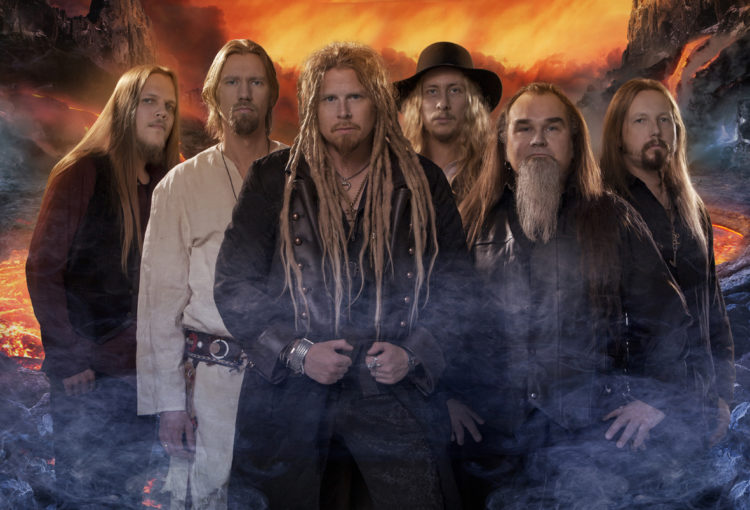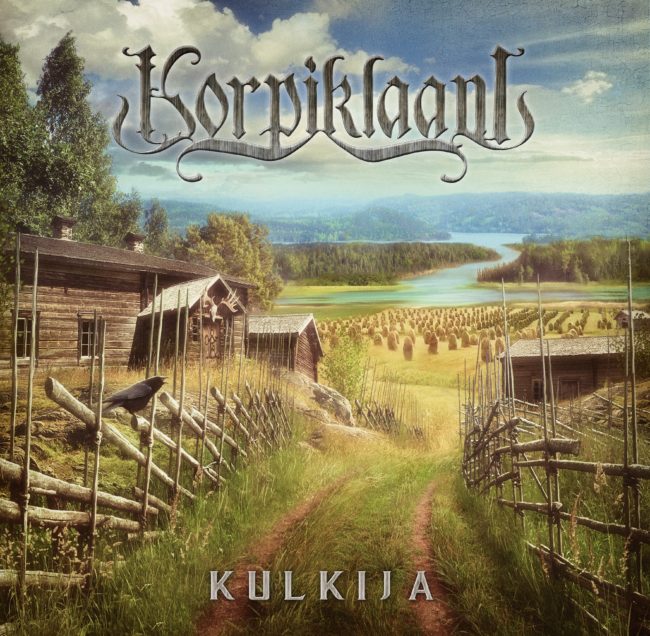
After 3 years since the last album, Finnish Folk Metal Superstars KORPIKLAANI offer their 10th album titled “Kulkija”(“Wanderer”), set for a September 7th, 2018 release.
Concluding 14 (!) tracks, »Kulkija« is their longest album, but also their most natural sounding one to date. “That’s what you can clearly hear. It’s closer to how we sound on stage, and we’ll be able to play all new songs live, that’s for sure,” explains Jonne. For tracking, the band members mostly used their current tour rig.
And the result was definitely worth the waiting. From the first to the last tone, a unique atmosphere guides the listeners through a long journey.
“It’s not just a collection of songs, it’s a ‘real’ album,” states Sami. Adds Jonne, “It needed many songs to create this atmosphere, and the record’s flow is really good too. You should definitely listen to »Kulkija« as a whole. The more you listen to the record, the more details you can find.” Sami Perttula explains further, “We really took our time and recorded it piece by piece. All songs were also well prepared in advance and nothing needed to be arranged in the studio like sometimes before.”
Also, instrumentally, the band continues the way they had already started from “Manala” (2012) to “Noita” (2015).
“The characters of all instruments are more balanced than ever before. For the first time, I had the chance to play such a wide range of emotions on a metal album, and didn’t only have to focus on playing everything hard or in a rock style. I could use more of my expressional skills,” comments fiddler Tuomas.
Lyrically, the album deals with the album’s title character, the wanderer. He appears in every song and every single track represents one of his life situations. For example, ‘Neito’ deals with his woman. “The woman is the road, and as much as the wanderer loves being on the road, so much he loves his maiden,” explains Jonne (all roughly translated song titles can be found below). The album can even mostly be transferred to the band’s life on the road, far from home, which makes it probably also KORPIKLAANI’s most personal and emotional album. But now onwards to KORPIKLAANI’s new music.
“Kulkija” begins with a band-typical opening trio in the form of ‘Neito’, ‘Korpikuusen Kyynel’ and ‘Aallon Alla’, but then a beautiful acoustic ballad entitled ‘Harmaja’, gives the listener a first break to take breath. Continuing with ‘Kotikonnut’, also the first single, ‘Korppikalliota’ leads to ‘Kallon malja’, which is the album’s longest track with about 10 minutes. Track 8, the doomy ‘Sillanrakentaja’, surprises with a children’s choir (feat. Cane’s and Jonne’s kids), before ‘Henkselipoika‘ takes over. This song could sound familiar to some people as it already premiered live on KORPIKLAANI’s extensive European tour with HEIDEVOLK, ARKONA and TROLLFEST in early 2018. The instrumental track ‘Pellervoinen‘, written by fiddler Tuomas, opens up the last third of “Kulkija” with its charming folk arrangements, followed by ‘Riemu’ and ‘Kuin korpi nukkuva’, before another high-paced track, ‘Juomamaa’, leads to the peaceful outro, ‘Tuttu on tie’.
The mastering skills of renowned engineer Svante Forsbäck (RAMMSTEIN a.o.), who already worked with the band on »Live at Masters of Rock« (2017), gave the record its unique sound.
“This record is so easy to listen to and interesting all the time, the balance is simply perfect,” he states. “We’ve never been as satisfied with a final result as we are with »Kulkija«,” confirms Jonne.
“Kulkija” was recorded in November 2017 at Petrax Studio (Hollola, Finland) and mixed at Sound Supreme Studio (Hämeenlinna, Finland) with producer/mixing engineer Janne Saksa and the final result presents the band as you’ve never heard them before. The corresponding detailed cover artwork was designed by Jan Yrlund (BATTLE BEAST, MANOWAR a.o.), who has been designing their covers since their 3rd album, and shows a beautiful landscape, based on a real photo taken by Jan at Huhtalan torppa, Kuhmoinen, Finland.
After their foundation by frontman Jonne Järvelä in 2003, KORPIKLAANI was very productive and has already released an impressive amount of 9 studio albums (sometimes almost one album a year) plus a live DVD/Blu-ray (“Live at Masters of Rock,” 2017) in their only 15-year spanning career.
“Kulkija” – Track Listing:
- Neito (“Maiden”)
The road is a wanderer’s bride, a maiden who he misses and who he travels with. However, the real maiden is waiting for his return home. After a journey you may bury your carriage, but the wistful traveler’s songs and music will be carried where it lies. A traveler was born to wander.
- Korpikuusen kyynel (“Moonshine”)
The Finnish equivalent for moonshine, korpikuusen kyynel (”a tear of the backwoods spruce”), refers to self-made hard liquor that was secretly distilled and shed like tears in the middle of the forest. Enjoying his carefree life, the moonshiner in the song sees the world around him from his hiding place.
- Aallon alla (“Under The Wave”)
A song of the drowning one. The lake and the sea are unpredictable. They are the oarsman’s grave. No wings or riches are of help when the drowning man falls on the swinging waves. The oarsman in the story cannot hear the cry of the drowning one, which could be heard by a deaf one. The waves can also be seen as safe: they drift you silently towards eternity.
- Harmaja (“The Grey”)
The blackcap (Sylvia atricapilla), the bird in the song, has been unable to migrate south because of a broken wing. The song depicts anxiety and the fading memory. . A Finnish poet Zachris Topelius wrote in 1853 a poem titled “Sylvian joululaulu” about homesickness which is referred to by “laulu kaipauksen” (a song of yearning) in the song. The song can also mean the “greyness” when a partner of an old couple dies.
- Kotikonnut (“Homestead”)
During his journey, a wanderer yearningly looks back on his home, childhood and the beauty of everything. He remembers running with his girl on the meadow, believing it to last till the end of times. Although his home is now the road and a carriage run on joy, he will still always remember the happiness of his home and youth. At the time the moon was golden, shining everywhere at night, lighting up the otherwise dark countryside and the forest. The wanderer eventually accepts that everything that comes, will one day fade into a distant memory.
- Korppikalliota (“The Raven’s Rock”)
A black raven has been considered the bird of the devil, even a bringer of death. It has been assembled from embers and burned wood. In ancient songs it was asked to carry a singer’s worries and drown them into a fishless pond. The raven was believed to be capable of living hundreds of years. It was also believed to be so wise that it could dodge a bullet shot at it. Old and wise, the raven in the song sings at the top of a tall spruce, telling who has died at the root of the tree.
- Kallon malja (“Chalice Of The Skull”)
The text, in first person, is set in the wintry wilderness of Lapland, surrounded by fells and with a campfire flowing together with his fiery, beautiful hair before him. He has got one eye from a horned creature and one from a blazing sky. With these eyes he watches the snow going through a dead tree and the dark sky with the Northern lights dancing on it. The animals gathering around him connect the narrator with wintry nature and make him part of the cycle.
- Sillanrakentaja (“Bridge Builder”)
At Lake Pyhäjärvi, located in the area of Eura and Säkylä, Finland, lies the end of Cape Hiittenkari. It is said to have been built by a giant, who wanted to build a bridge over the lake. While he was at it, the lady of the house turned up, ridiculing the torn clothes of the giant who worked hunched. Leaving his work unfinished, the giant took offense and tried to cast a large stone at the mean woman. The stone flew through the air and landed at the border of the Säkylä and Kauttua villages, becoming a boundary mark.
- Henkselipoika (“A Boy In Suspenders”)
The narrator in the song is a farmhand, who watches maids work while remaining lazy himself during a warm summer day. He would like to have one of the maids as his partner, but is unable to decide who. Fond of parties and fun, the farmhand ponders whether the maids have noticed him.
- Pellervoinen
Instrumental
- Riemu (“Joy”)
In a joyous mood, a reveler goes to the party venue. He walks through mounds, a forest and a field, at times thinking about whether he is wearing a veil of joy or madness defining his life.
- Kuin korpi nukkuva (“Like A Sleeping Forest”)
A wanderer dreams of an easy journey on an even road, with the girl of his dreams beside him. Returning home, he feels that he does not belong anywhere. The wanderer does not want to wake, as life is rife with fears and worries. At the end the dream the girl picks a dead flower, he wakes up, he realizes that he must live for today and not for tomorrow.
- Juomamaa (“Drinker’s Land”)
Some were born as wanderers, some as drunkards, some as both. This song depicts day- to-day drinking with friends and acquaintances. A drinker’s land is a place of enjoyment with no worries.
- Tuttu on tie (“The Road Is Familiar”)
A wanderer’s home is a nostalgic road that he must walk from day to day. On the road you have time to think about your longing and yearn for your lost love, yet being happy with what you have. The wanderer knows the road inside out, like the palms of his hands. He is accompanied by his friends: the sun and the moon. As the night falls, he closes his eyes, feeling the soft hand of longing on his cheek.
Read our review here.
